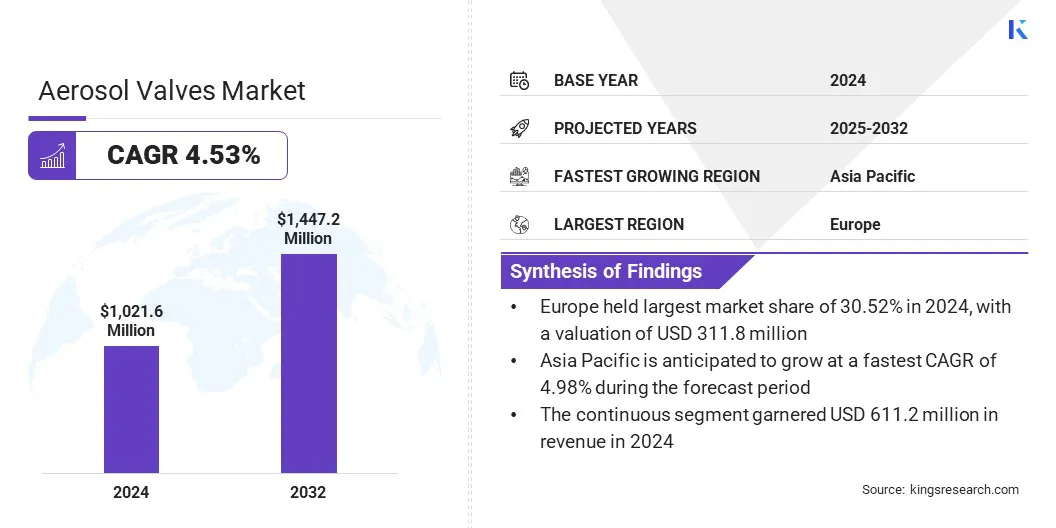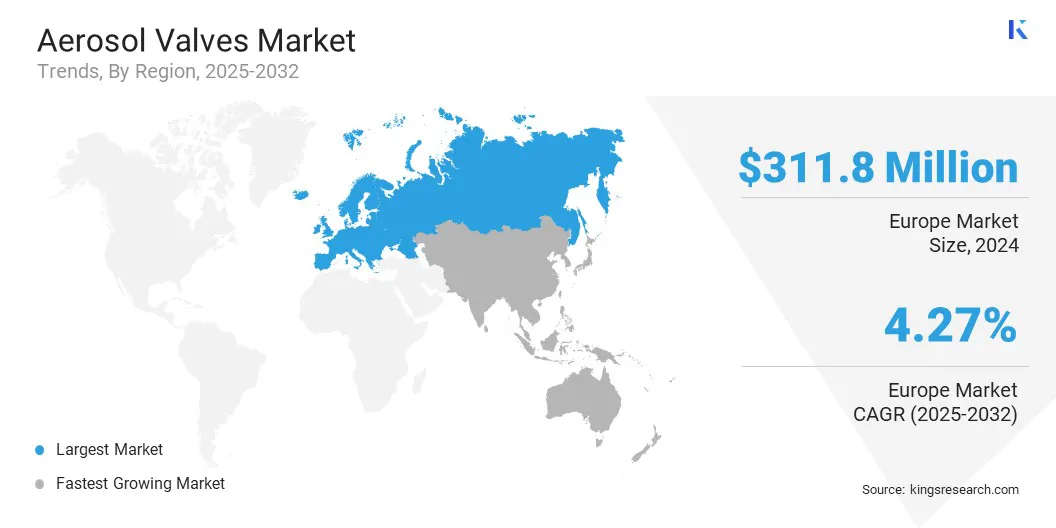Market Definition
The market comprises mechanical dispensing components designed to control the release of products from aerosol containers. These valves regulate the flow, pressure, and spray characteristics of liquids or gases released from pressurized packaging, supporting applications across personal care, household, automotive, medical, and food industries.
Market growth is driven by the rising demand for controlled dispensing solutions, enhanced user convenience, and improved product safety, making aerosol valves a vital component in modern packaging solutions.
Aerosol Valves Market Overview
The global aerosol valves market size was valued at USD 1,021.6 million in 2024 and is projected to grow from USD 1,061.3 million in 2025 to USD 1,447.2 million by 2032, exhibiting a CAGR of 4.53% during the forecast period.
This growth is attributed to the increasing consumption of personal care and household products, fueled by rapid urbanization and improved living standards. Expanding hygiene awareness and the increasing demand for convenient packaging solutions is further creating a strong demand for aerosol valves.
Key Highlights:
- The aerosol valves industry size was recorded at USD 1,021.6 million in 2024.
- The market is projected to grow at a CAGR of 4.53% from 2025 to 2032.
- Europe held a share of 30.52% in 2024, valued at USD 311.8 million.
- The continuous segment garnered USD 611.2 million in revenue in 2024.
- The medical segment is anticipated to witness the fastest CAGR of 4.63% over the forecast period.
- Asia Pacific is anticipated to grow at a CAGR of 4.98% through the projection period.
Major companies operating in the aerosol valves market are LINDAL Group, AptarGroup, Inc., Guangdong Zhongma Technology Development co. ltd., Coster Tecnologie Speciali S.p.A., Salvalco, Summit Packaging Systems, Precision Valve Corporation, Aroma Industries, Clayton Corp., Power Container Corp., and KOH-I-NOOR Mladá Vožice a.s.

The expansion of manufacturing facilities is enhancing production efficiency and supply capabilities, which is aiding market expansion. Companies are investing in new plants and automated production lines to meet rising demand across personal care, household, and medical sectors. These initiatives improve output, quality control, and shorter lead times, fostering competitiveness among global manufacturers.
Additionally, capacity expansion supports regional supply chains, reducing dependency on imports and logistics delays. These developments collectively contribute to operational optimization, technological advancement, and sustainable market growth.
- In August 2025, Salvalco, in partnership with Sanit & Sons, announced the construction of a new manufacturing facility in the Nakhon Nayok region near Bangkok. Scheduled to commence operations in January 2026, the facility will serve as the primary production hub for Salvalco’s expanding range of aerosol valves designed for inert gas propellants.
What technological innovations are enhancing precision and reliability in metered aerosol valve systems?
Ongoing advancements in metered aerosol valve technology are enhancing accuracy, product efficiency, and user control across diverse dispensing applications. Manufacturers are focusing on precision engineering and high-performance materials to ensure consistent spray volumes in pharmaceutical and cosmetic products. These developments improve dosage reliability while minimizing product wastage.
Ongoing research focused on integrating lightweight, corrosion-resistant components is further improving valve performance under high pressure. These innovations strengthen brand differentiation, ensure regulatory compliance, and increase user satisfaction, leading to widespread adoption in premium and functional aerosol categories.
- In April 2024, Coster Group launched its Bag-on-Valve aerosol valve featuring an integrated metering system. The design incorporates a bag within the can to separate the product from compressed gas propellants such as air or nitrogen, ensuring precise and controlled dispensing.
Why do high production costs pose a significant challenge for aerosol valve manufacturers?
High production costs associated with multi-component valve assemblies remain a major challenge due to the complexity of valve designs that require precision tooling, high-grade materials, and advanced assembly processes, increasing overall manufacturing expenses.
The dependence on metal alloys and specialized sealing elements further adds to cost pressures, particularly for small and medium-scale manufacturers striving to maintain profitability in competitive markets.
To address this challenge, manufacturers are adopting modular valve designs, leveraging automation in assembly, and sourcing cost-efficient materials. These measures reduce labor dependency, enhance production speed, and maintain performance standards, thereby improving manufacturing cost efficiency and scalability.
How is smart valve technology influencing efficiency and sustainability in aerosol systems?
Advanced valves equipped with sensors and programmable mechanisms regulate flow rate and pressure to ensure precise, consistent output, which is emerging as a notable trend in the aerosol valves market.
Smart dispensing technology enhances efficiency, minimizes wastage, and supports sustainable packaging initiatives. Growing use of digital control systems in pharmaceutical, personal care, and industrial applications reflects a shift toward intelligent packaging solutions, improving performance monitoring, user experience, and product differentiation in competitive markets.
- In November 2025, KAYALI selected AptarGroup’s all over spray premium aerosol valve for its new hair and body mists collection. The advanced packaging enables continuous 360° dispensing that ensures precise diffusion and consistent dosage.
Aerosol Valves Market Report Snapshot
|
Segmentation
|
Details
|
|
By Type
|
Continuous, Metered
|
|
By Application
|
Personal Care, Household, Automotive & Industrial, Food Industry, Medical, Others
|
|
By Region
|
North America: U.S., Canada, Mexico
|
|
Europe: France, UK, Spain, Germany, Italy, Russia, Rest of Europe
|
|
Asia-Pacific: China, Japan, India, Australia, ASEAN, South Korea, Rest of Asia-Pacific
|
|
Middle East & Africa: Turkey, U.A.E., Saudi Arabia, South Africa, Rest of Middle East & Africa
|
|
South America: Brazil, Argentina, Rest of South America
|
Market Segmentation
- By Type (Continuous and Metered): The continuous segment generated USD 611.2 million in revenue in 2024, mainly due to its extensive use in personal care and household products requiring uninterrupted spray performance and user convenience.
- By Application (Personal Care, Household, Automotive & Industrial, Food Industry, Medical, and Others): The medical segment is poised to record a CAGR of 4.63% through the forecast period, propelled by rising adoption of aerosol-based drug delivery systems and sterilized packaging solutions ensuring precise and hygienic dispensing.
What is the market scenario in Europe and Asia Pacific region?
Based on region, the global aerosol valves market has been classified into North America, Europe, Asia Pacific, Middle East & Africa, and South America.

Europe aerosol valves market share stood at 30.52% in 2024, valued at USD 311.8 million. This notable expansion is supported by a strong manufacturing base and advanced packaging infrastructure. Steady demand from personal care, household, and industrial sectors continues to boost the adoption of aerosol packaging formats.
The regional market further benefits from continuous investment in automation technologies and R&D to enhance production efficiency and environmental standards. Sustainability regulations are prompting the use of recyclable materials and low-emission propellants.
- In October 2025, Alupro, in collaboration with SUEZ Recycling and Recovery UK through the UK Aerosol Recycling Initiative (UKARI), launched a communications program in two UK local authorities to improve post-consumer aerosol recycling. The program uses creative messaging to drive recycling behavior and applies household waste data to refine campaign strategies.
The Asia Pacific aerosol valves industry is projected to grow at a CAGR of 4.98% over the forecast period, supported by rapid industrial development and expanding consumer goods sectors. Rising demand for personal care, automotive, and healthcare aerosols is fueling consumption, while urbanization and improving living standards are fostering the adoption of convenient packaging solutions.
Local manufacturers are increasing production capacities and forming supply partnerships to meet increasing domestic and export requirements. Additionally, the regional market benefits from low-cost manufacturing infrastructure and advancing technologies in valve design and assembly.
Regulatory Frameworks
- In the U.S., the Environmental Protection Agency (EPA) Clean Air Act regulates the emission of volatile organic compounds (VOCs) from aerosol products. It enforces limits on propellant usage and formulation standards to reduce air pollution and ensure compliance with environmental safety norms relevant to aerosol valve manufacturers.
- In the EU, the Registration, Evaluation, Authorisation and Restriction of Chemicals (REACH) Regulation oversees the safe use of chemical substances in aerosol products. It mandates manufacturers to assess and disclose material safety, influencing raw material selection and formulation in valve and propellant systems.
- In Japan, the High Pressure Gas Safety Act governs the production, storage, and transportation of pressurized gases used in aerosol systems. It directs safety testing and certification procedures for valve performance, ensuring structural integrity under high pressure conditions.
- In Canada, the Canadian Environmental Protection Act (CEPA) supervises the environmental impact of aerosols and propellants. It requires manufacturers to adhere to sustainability guidelines and reduce ozone-depleting substances used in aerosol packaging.
- In China, the Measures for the Environmental Management of New Chemical Substances (MEE Order No. 12) governs the registration and environmental risk assessment of chemicals used in aerosol production. It enforces compliance for propellant safety, emission control, and material traceability within the aerosol valves manufacturing process.
Competitive Landscape
Key players operating in the aerosol valves industry are expanding manufacturing capacities and adopting automation to enhance large-scale production efficiency. Strategic mergers, acquisitions, and partnerships are strengthening market presence and broadening product portfolios. Firms are investing in research and development to develop lightweight, recyclable, and precision-based valve systems aligned with sustainability trends.
Continuous process optimization and quality standardization remain vital for maintaining operational efficiency and brand reliability. Additionally, firms are focusing on geographic expansion into emerging markets and diversification across end-use industries.
- In October 2023, LINDAL Group expanded its production capacity by introducing new Bag-on-Valve manufacturing lines in Europe and North America. The upgraded facilities in Briey and Columbus are designed to enhance global supply efficiency, reduce lead times, and support growing customer demand through improved operational scalability.
Key Companies in Aerosol Valves Market:
- LINDAL Group
- AptarGroup, Inc.
- Guangdong Zhongma Technology Development co. ltd.
- Coster Tecnologie Speciali S.p.A.
- Salvalco
- Summit Packaging Systems
- Precision Valve Corporation
- Aroma Industries
- Clayton Corp.
- Power Container Corp.
- KOH-I-NOOR Mladá Vožice a.s.
Recent Developments (Product Launches)
- In July 2024, Salvalco expanded its product portfolio with the launch of Eco-Dose, a metered aerosol valve compatible with inert gas propellants. Specifically designed for air freshener applications, Eco-Dose delivers consistent performance comparable to LPG valves while advancing sustainability through its patented dosing technology.


